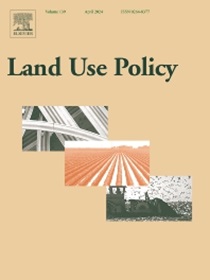Effect of farmland scale on agricultural green production technology adoption: Evidence from rice farmers in Jiangsu Province, China
IF 5.9
1区 社会学
Q1 ENVIRONMENTAL STUDIES
引用次数: 0
Abstract
Agricultural green production technology (AGPT) is crucial for mitigating farmland pollution and degradation, as well as promoting green agricultural development. Using data from 774 rice farmers in the 2021 China Land Economy Survey (CLES), the study analyzes the impact mechanisms and mediating pathways of farmland scale on AGPT adoption at both the farmer and plot levels. The study also reveals the differences in impact based on the heterogeneity of plot concentrations and technological attributes. The results show that: (1) Farmland scale positively impacts AGPT adoption, both at the farmer and plot level. (2) Farmland scale positively impacts AGPT adoption at two levels by affecting commercialization rate, time preference, and machinery investment. (3) The positive impact of farmland scale are heterogenous at two levels. When rice is scatteringly planted, plot scale has a more significant impact on AGPT adoption than operation scale; however, when rice is concentratedly planted, the situation is the opposite. Additionally, when faced with "capital-increasing, labor-saving, and risks-increasing" technology, operation scale has a more significant impact on AGPT adoption than plot scale; however, when faced with "capital-stabilizing, labor-increasing, and risks-controlling" technologies, the situation is the opposite. These findings help to provide policy implications for promoting AGPT adoption and sustainable farmland use.
耕地规模对农业绿色生产技术采用的影响:来自中国江苏省水稻种植户的证据
农业绿色生产技术(AGPT)对于缓解农田污染和退化、促进农业绿色发展至关重要。本研究利用 2021 年中国土地经济调查(CLES)中 774 个水稻种植农户的数据,从农户和地块两个层面分析了耕地规模对农业绿色生产技术采用的影响机制和中介途径。研究还揭示了基于地块集中度和技术属性异质性的影响差异。研究结果表明(1) 在农户和地块层面,农田规模对 AGPT 的采用都有正向影响。(2) 耕地规模通过影响商品化率、时间偏好和机械投资,在两个层面上对 AGPT 的采用产生积极影响。(3) 耕地规模的积极影响在两个层面上具有异质性。当水稻分散种植时,地块规模对 AGPT 采用的影响比经营规模更显著;但当水稻集中种植时,情况恰恰相反。此外,在面对 "增加资本、节省劳力、增加风险 "的技术时,经营规模对 AGPT 采用率的影响比地块规模更显著;但在面对 "稳定资本、增加劳力、控制风险 "的技术时,情况则相反。这些发现有助于为促进 AGPT 的采用和农田的可持续利用提供政策启示。
本文章由计算机程序翻译,如有差异,请以英文原文为准。
求助全文
约1分钟内获得全文
求助全文
来源期刊

Land Use Policy
ENVIRONMENTAL STUDIES-
CiteScore
13.70
自引率
8.50%
发文量
553
期刊介绍:
Land Use Policy is an international and interdisciplinary journal concerned with the social, economic, political, legal, physical and planning aspects of urban and rural land use.
Land Use Policy examines issues in geography, agriculture, forestry, irrigation, environmental conservation, housing, urban development and transport in both developed and developing countries through major refereed articles and shorter viewpoint pieces.
 求助内容:
求助内容: 应助结果提醒方式:
应助结果提醒方式:


